Letter from the Editors
Our world is filled with erotic energy.
The word erotic is loaded and, at best, ambiguous; yet, for most of us, it’s also excitatory. It elicits
sensations, memories, fantasies, an entire world that is most often submerged below the surface of our
everyday selves. But what, exactly, is erotic and what does it mean to publish a magazine dedicated to
the erotic in arts and literature?
Perhaps in contemplating the erotic, we should gaze backwards toward ancient Greece where the
concept was borne from the flutter of Eros’s wings. The word erotic comes from the Greek myth of Eros.
Eros, once a primordial force within the universe and then, in later myths, the offspring of Aphrodite and
Ares, Eros came to represent those forces of love and fertility. In part, the early myths have endured and
even transmutated from culture to culture because they capture the complexity of the human experience and distill it into simple archetypes and stories. Eros is no different. Though Eros’s origins evolved over time, he has remained a force active in the lives of all of us, igniting within us our own carnality and desire.
With this in mind, I like to think of Eros as the seat of our soul from which the most primal and sexual
parts of our natures emerge. The erotic, then, is the form in which our carnality takes shape.
When contemplating the themes of Pink Disco, I thought hard about what it means to feel that energy.
On the one hand, we could easily look at what has become commodified as sex in our society and point
to that as erotic. To some extent, this works. But I also firmly believe some of the most potent sex we
encounter is found in the sublime and secret whispers of our everyday lives.
Don’t get me wrong. Pink Disco welcomes latex, leather, nipple clamps, and feathers. We want to see your O face. But we also believe the most explicit sex is not an isolated act but the apex of the totality of our experience; it is a celebration of what it means to be human, to have a body, and to experience sensation.
Pink Disco, then, is a celebration of the erotic, our carnality, our bodies, and ultimately our humanness.
Come play with us.
Pink
ALL TIED UP
June 20, 2025
Letter from the Editor-in-Chief
With this issue, we continue the theme of Play Party with All Tied Up. The idea for this year’s theme was to
bring us through different levels of intensity often associated with any sort of play, ordeal, or gnostic
experience. This coupling of gnosis and play is accentuated in an essay I contributed for the issue, “All Tied
Up: Eight Meditations, A Conversation with Lee Harrington.” First and foremost, I was honored for the
opportunity to talk with Lee, who is a nationally renowned sexuality educator and a pioneer in bringing rope
bondage to the mainstream. The practice of rope bondage is simultaneously exquisite in its beauty and an
ordeal of bodily endurance.
Of course, the work presented in this issue isn’t exclusively centered on the physical act of bondage, nor play, though you’ll find allusions to those themes throughout. As with every issue, these themes serve primarily as a launch pad and in this issue you’ll find pieces that explore the ways in which we become entangled in our relationships with our bodies and with each other. The idea of entanglement is beautifully captured in Naa Asheley Ashitey’s poem “Write a poem about the difference between love and erotica”:
This issue also features the three winners of our fiction writing contest. You’ll find their works directly below and I’m immensely grateful for the opportunity for us to host a contest of this kind.
As always, this magazine couldn’t be possible without the generous contributions from each of the featured artists. To each of you, for your trust, I am indebted.
With love and gratitude.
Following that are the amazing PAINTINGS of Sabyasachi Roy. Read that again. These beautiful black and white images are painted. They are not digital photographic representations. I encourage you to click (or tap) for a closer look at the brushstroke and the texture of the canvas itself - not so dissimilar to the feel of a rope, though that was probably unintentional.
Finally, is Rachel Turney’s second submission and subsequent acceptance. Another male model from the back in black and white, this time sporting an apron, a ’cheeky‘ take on the theme.
Next edition will be a theme of Masquerade. Dust off your feathered masks, long gloves, heels, and corsets and capture the mysterious imagery in your medium of choice.
___
This issue’s playlist can be found here.
Of course, the work presented in this issue isn’t exclusively centered on the physical act of bondage, nor play, though you’ll find allusions to those themes throughout. As with every issue, these themes serve primarily as a launch pad and in this issue you’ll find pieces that explore the ways in which we become entangled in our relationships with our bodies and with each other. The idea of entanglement is beautifully captured in Naa Asheley Ashitey’s poem “Write a poem about the difference between love and erotica”:
I too did not see nor believe that love and erotica could intertwine.
When I decorated his fingers with silver and black rings so that my favorite
necklace could leave bruises on my neck, the aim was not satisfaction;
and trust was simply an afterthought.
I was simply rewriting my history. It was control.
When I decorated his fingers with silver and black rings so that my favorite
necklace could leave bruises on my neck, the aim was not satisfaction;
and trust was simply an afterthought.
I was simply rewriting my history. It was control.
This issue also features the three winners of our fiction writing contest. You’ll find their works directly below and I’m immensely grateful for the opportunity for us to host a contest of this kind.
As always, this magazine couldn’t be possible without the generous contributions from each of the featured artists. To each of you, for your trust, I am indebted.
With love and gratitude.
Letter from the Art Editor
The themes we present to you on the first day of each season are meant as inspiration to contributors or to spark a memory of something created months passed, a cosmic alignment of ideas. All Tied Up can be taken quite literally, as did Daniel David with his collection of six collages, the first example of PD accepting a full half-dozen of work. The pieces are too thought-provoking in their stark juxtaposition of photography and illustration as to not be accepted, even if we chose to ignore how perfectly they ladder up against the present thematic trappings.Following that are the amazing PAINTINGS of Sabyasachi Roy. Read that again. These beautiful black and white images are painted. They are not digital photographic representations. I encourage you to click (or tap) for a closer look at the brushstroke and the texture of the canvas itself - not so dissimilar to the feel of a rope, though that was probably unintentional.
Finally, is Rachel Turney’s second submission and subsequent acceptance. Another male model from the back in black and white, this time sporting an apron, a ’cheeky‘ take on the theme.
Next edition will be a theme of Masquerade. Dust off your feathered masks, long gloves, heels, and corsets and capture the mysterious imagery in your medium of choice.
___
This issue’s playlist can be found here.
Fiction Contest
FIRST PLACE
Wild Children
SECOND PLACE
The First Meeting
THIRD PLACE
976
Visual Art
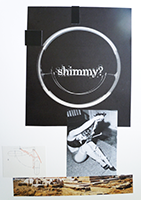

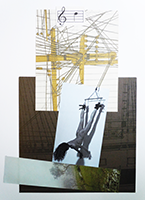
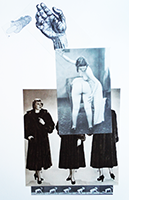
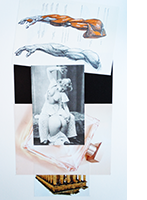
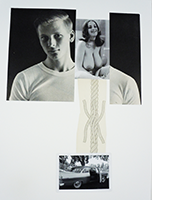
The Human Domain 44
The Human Domain 45
The Human Domain 46
The Human Domain 47
The Human Domain 48
The Human Domain 49
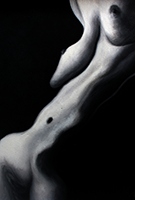
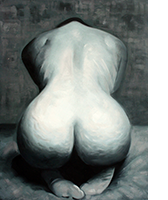
Fatehpur454
Back

The Baker
Poetry
“Write a poem about the difference between love and erotica”
Sex Duplex
the night gardener
A Vision at the Lake
Anxious Attachment Style
I, Pagan
Nonfiction
All Tied Up: A Conversation with Lee Harrington
Even the Pornstars are Clipfarming
UHS Class of ’71
Mine. Myn. Min.
Fiction
Wedding Preparations
The Cruise
Noon
Nude Tuesday

